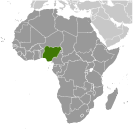Nigeria is home to seven percent (7%) of the total languages spoken on earth. Taraba state alone has more languages than 30 African countries. The importance of this fact is appreciated when one understands that language is the “soul of culture” (as Ngugi wa Thiongo famously said). It is language that births the proverbs, riddles, stories and other aspects of culture that give us identity. UNESCO puts forward that the world’s languages represents an extraordinary wealth of creativity. Linguistic diversity correlates with cultural diversity. This means Nigeria can look inwards and drive itself to become the greatest hub for cultural tourism on earth, and consequently empower its citizens tremendously in the process.
The Walls of Benin (800-1400AD), in present day Edo State, are the longest ancient earthworks in the world, and probably the largest man-made structure on earth. They enclose 6500 square kilometers of community lands that connected about 500 communities. At over 16000km long, it was thought to be twice the length of the Great Wall of China, until it was announced in 2012 (after five years of meticulous measurement by Chinese surveyors) that the Great Wall is about 21,000km long.
The Yoruba tribe has the highest rate of twin births in the world. Igbo-Ora, a little town in Oyo state, has been nicknamed Twin capital of the World because of its unusually high rate of twins that is put as high as 158 twins per 1000 births. In a video I watched last year on YouTube presented by Titi (a white lady who speaks Yoruba), and which was centred on twin births in Igbo-Ora, one of the locals boasted that every family in the town has at least one twin!
Sarki Muhammad Kanta The Great of Kebbi, was the only ruler who resisted control by Songhai, West Africa’s greatest empire at that time. He founded and ruled the Hausa city-state of Kebbi around 1600 A.D and built Surame its capital, a planned city which was almost impossible to penetrate during war. In fact UNESCO describes Surame as “one of the wonders of human history, creativity and ingenuity”, and probably the most massive stone-walled constructions in West Africa. He is listed in Robin Walker’s 50 Greatest Africans.
Africa’s oldest known boat is The Dufuna canoe which was discovered in Dufuna village, Yobe state, by a Fulani Herdsman in May 1987, while he dug a well. Various radio-carbon tests conducted in laboratories of reputable universities in Europe and America indicate that the canoe is over 8,000 years old, thus making it the oldest in Africa and 3rd oldest in the world. The discovery of the canoe has completely changed accepted theories of the history and sophistication of marine technology in Africa.
Sungbo’s Eredo, a 160 km rampart equipped with guard houses and moats, is reputed to be the largest single pre-colonial monument (or ancient fortification if you like) in Africa. It is located in present-day Ijebu-Ode, Ogun State and when it was built a millennium ago, it required more earth to be moved during construction than that used for building the Great Pyramid of Giza (one of the Seven Wonders of The Ancient World). The most astonishing thing is that Sungbo’s Eredo was the biggest city in the world (bigger than Rome and Cairo) during the Middle Ages when it was built!
Sarki Abdullah Burja of Kano (ruled 1438-1452 AD), the 18th ruler of Ancient Kano, created the first Golden Age in Northern Nigeria and ushered in a period of great prosperity. During his reign, Hausa became the biggest indigenous language spoken in Africa after Swahili. He is on the list of 50
Greatest Africans in Robin Walker’s wonderful book, “When We Ruled”.
The Jos Plateau Indigobird, a small reddish-brown bird, is found nowhere else on the planet but Plateau state, Nigeria.
The Anambra waxbill, a small bird of many beautiful colours, is found only in Southern Nigeria and nowhere else on earth.
The Niger Delta (which is the second largest delta on the planet), has the highest concentration of monotypic fish families in the world, and is
also home to sixty percent of Nigeria’s mangrove forests. You should know too that Nigeria’s mangrove forests are the largest in Africa and third largest on earth.
According to the World Resources Institute, Nigeria is home to 4,715 different types of plant species, and over 550 species of breeding birds and mammals, making it one of the most ecologically vibrant places of the planet.
Ile-Ife, in present day Osun State, was paved as early as 1000AD, with decorations that originated from Ancient America suggesting there might have been contact between the Yorubas and the Ancient Americans half a millenium before Columbus ‘discovered’ America.
contributed by Samuel Okopi
